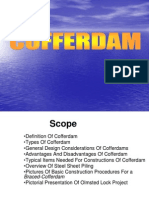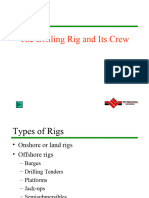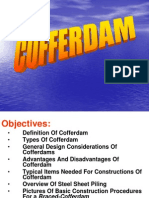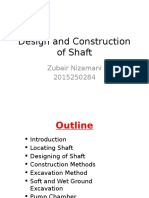Professional Documents
Culture Documents
Rigs 23
Rigs 23
Uploaded by
Vijay Hatkar0 ratings0% found this document useful (0 votes)
10 views11 pagesThis document discusses challenges with drilling and sampling in sticky clayey silts and weathered carbonate rocks, as well as problematic residual soil profiles. It provides examples of difficult site access conditions and describes temporary solutions like cribbing and drilling platforms. A variety of drilling rig options are presented for different terrain, including truck-mounted, smaller tracked, and remote-controlled rigs.
Original Description:
Original Title
RIGS 23
Copyright
© © All Rights Reserved
Available Formats
PDF, TXT or read online from Scribd
Share this document
Did you find this document useful?
Is this content inappropriate?
Report this DocumentThis document discusses challenges with drilling and sampling in sticky clayey silts and weathered carbonate rocks, as well as problematic residual soil profiles. It provides examples of difficult site access conditions and describes temporary solutions like cribbing and drilling platforms. A variety of drilling rig options are presented for different terrain, including truck-mounted, smaller tracked, and remote-controlled rigs.
Copyright:
© All Rights Reserved
Available Formats
Download as PDF, TXT or read online from Scribd
Download as pdf or txt
0 ratings0% found this document useful (0 votes)
10 views11 pagesRigs 23
Rigs 23
Uploaded by
Vijay HatkarThis document discusses challenges with drilling and sampling in sticky clayey silts and weathered carbonate rocks, as well as problematic residual soil profiles. It provides examples of difficult site access conditions and describes temporary solutions like cribbing and drilling platforms. A variety of drilling rig options are presented for different terrain, including truck-mounted, smaller tracked, and remote-controlled rigs.
Copyright:
© All Rights Reserved
Available Formats
Download as PDF, TXT or read online from Scribd
Download as pdf or txt
You are on page 1of 11
Sticky Clayey Silt
• One of the most challenging conditions to drill
and sample in are sticky clayey silts, such as
those pictured here; which stick to the auger
flights
• Loss of drilling fluid circulation is common in
weathered carbonate rocks with open cavities.
Clay-filled cavities can be also problematic
where they contain rock ‘floaters’
Residuum
• Residual soils
profiles can be
highly undulatory
and anisotropic, as
portrayed here
• Beware of deeply
incised weathering
zones along faults,
shears, contacts,
fold axes, or
lithologic horizons
• Typical weathering profiles in metamorphic and
igneous rocks. Floating clasts are always problematic
in developing reliable cross sections.
DEALING WITH
DIFFICULT SITE
ACCESS CONDITIONS
CRIBBING
STANDS
• In the old days,
temporary wood or
steel cribbing was
erected to support a
drilling platform, or
‘pad’, as shown here
along Pacific Coast
Highway in Pacific
Palisades, California
in 1940.
Drilling
Platforms
• This shows a
temporary drilling
platform set up
across the narrow
gorge of the Little
Colorado River, near
Cameron, Arizona in
the early 1940s
• Such platforms are
removed after drilling
Truck-mounted
drill rigs
• Generally used on
semi-level ground,
if easy site access
• Quick set-up
• Rate of advance
depends on height
of mast & drill
strings
• Large normal force
can be employed
(see left below)
• Some lighter 4WD equipped drill rigs can be
employed on uneven ground and in hillside
situations, using the hydraulic leveling rams.
Tracked Rigs
• A number of
manufacturers
offer tracked rigs
of varying size
• These can be
extremely useful
when working on
sift or sloping
ground
Tracked Rigs
Smaller tracked rigs can be
operated remotely, using radio
controls
Largest production tracked rig is
the CME 850, shown at left
You might also like
- Shaft SinkingDocument116 pagesShaft SinkingKedar nath Barik100% (2)
- Coiled Tubing Operations at a Glance: What Do You Know About Coiled Tubing Operations!From EverandCoiled Tubing Operations at a Glance: What Do You Know About Coiled Tubing Operations!Rating: 5 out of 5 stars5/5 (2)
- Well FoundationDocument32 pagesWell FoundationAnya Panda100% (1)
- Bridge EngineeringDocument93 pagesBridge EngineeringGokul KannanNo ratings yet
- Types of Drilling Rigs PDFDocument53 pagesTypes of Drilling Rigs PDFsatriaputra_samudraNo ratings yet
- CH 3Document29 pagesCH 3MekonenNo ratings yet
- Well FoundationDocument45 pagesWell Foundationmonika chauhan100% (2)
- 1 - 1 The Drilling RigDocument46 pages1 - 1 The Drilling Rigahmed otmanNo ratings yet
- Mine Development Vertical LatestDocument97 pagesMine Development Vertical LatestAnkit ChaudharyNo ratings yet
- Well FoundationsDocument26 pagesWell FoundationsmahtoNo ratings yet
- Wells and CaissonsDocument57 pagesWells and CaissonsRijoGeorge100% (1)
- L2 Piles in LimestoneDocument11 pagesL2 Piles in Limestoneedward the iiiNo ratings yet
- Lecture 12alt The Quasi Open Pit MethodsDocument19 pagesLecture 12alt The Quasi Open Pit MethodsudivulcanNo ratings yet
- 9 Well FoundationsDocument77 pages9 Well FoundationsRajesh Khadka80% (5)
- Caissons AND Coffer Dams: Department of Civil Engineering Parul University - P.I.E.TDocument27 pagesCaissons AND Coffer Dams: Department of Civil Engineering Parul University - P.I.E.TÂsÏF MåñSùRï100% (1)
- Chapter - 09: Well FoundationsDocument77 pagesChapter - 09: Well Foundationsdhedy husadaNo ratings yet
- Landslide MitigationDocument129 pagesLandslide MitigationKapil AroraNo ratings yet
- Well FoundationDocument26 pagesWell FoundationMohit SinglaNo ratings yet
- Chapter 4 Drilling OperationsDocument36 pagesChapter 4 Drilling OperationsDeniz AkoumNo ratings yet
- Prof. Sathish Kumar-Rockfill DamsDocument80 pagesProf. Sathish Kumar-Rockfill DamsGAURAV KUMAR PATHAKNo ratings yet
- 04-2 - Supported - NT DevelopmentDocument39 pages04-2 - Supported - NT Developmentbonganimduduzi466No ratings yet
- L17 Cellular CofferdamDocument38 pagesL17 Cellular CofferdamMohammed Al KhatibNo ratings yet
- Drilling Rig TypesDocument25 pagesDrilling Rig TypesemenneNo ratings yet
- Peralatan PemboranDocument42 pagesPeralatan PemboranJimmy Agung Silitonga100% (1)
- CofferdamDocument42 pagesCofferdamRavi Shankar Kaushik60% (5)
- Presentation On Deep FoundationDocument58 pagesPresentation On Deep FoundationKanishka VermaNo ratings yet
- Ug Mining Note 3Document15 pagesUg Mining Note 3zeldsvonzdutchNo ratings yet
- 1.5 Piling and Piling TechniquesDocument18 pages1.5 Piling and Piling TechniquesshingkeongNo ratings yet
- Lecture Six HSIDocument80 pagesLecture Six HSIlivNo ratings yet
- CTPM EarthworkDocument68 pagesCTPM Earthworkkalyan100% (1)
- Introduction Drill Compl Intervention Fjelde 2012Document29 pagesIntroduction Drill Compl Intervention Fjelde 2012Qingming MaNo ratings yet
- Offshore Drilling RigsDocument19 pagesOffshore Drilling RigsAbhijith DwvadasNo ratings yet
- FE 02-02 Rig Types and Rig CrewDocument28 pagesFE 02-02 Rig Types and Rig Crewtemocc91No ratings yet
- A PRESENTATION On Modes of EntryDocument28 pagesA PRESENTATION On Modes of EntryRîtweek Þânɖey75% (4)
- A Brief Presentation On Cofferdam - FinalDocument41 pagesA Brief Presentation On Cofferdam - FinalHuda CuetNo ratings yet
- Downhole Drilling Problems (Pipi Sticking)Document45 pagesDownhole Drilling Problems (Pipi Sticking)مصطفى علي مخلف جوادNo ratings yet
- Foundation Selection ProcessDocument38 pagesFoundation Selection ProcessGabriel Alexis Malagon Carvajal100% (1)
- Site Investigation and Laboratory TestingDocument14 pagesSite Investigation and Laboratory Testinghiran peirisNo ratings yet
- Advances in Drilling TechnologyDocument46 pagesAdvances in Drilling TechnologySaurabh SinghNo ratings yet
- Dams ReservoirsDocument25 pagesDams Reservoirsc.vibha100% (4)
- ch-9 Well FoundationDocument27 pagesch-9 Well FoundationRJ JordanNo ratings yet
- 2.4 Coffer DamsDocument18 pages2.4 Coffer DamsHARIJITH K S CEB19-23No ratings yet
- Massive Mining PDFDocument70 pagesMassive Mining PDFogntshabeleNo ratings yet
- Advance Construction TechnologyDocument83 pagesAdvance Construction TechnologyRajesh DarjiNo ratings yet
- Test 1 Underground Mining: Question 1aDocument5 pagesTest 1 Underground Mining: Question 1aTamani MoyoNo ratings yet
- Reliance Drilling PDFDocument55 pagesReliance Drilling PDFsambhajiNo ratings yet
- CofferdamDocument41 pagesCofferdamSukhwinder Singh Gill0% (1)
- Underground Mining MethodDocument73 pagesUnderground Mining MethodMekonenNo ratings yet
- 1.7 CofferdamDocument33 pages1.7 CofferdamBia Mughal100% (2)
- Piers and CassionsDocument19 pagesPiers and CassionsTsegaye TsegayeNo ratings yet
- Pipe Laying MethodsDocument101 pagesPipe Laying MethodsSayan Manna100% (2)
- Design and Construction of ShaftDocument24 pagesDesign and Construction of ShaftZubair Nizamani100% (3)
- 3rd ModuleDocument65 pages3rd ModuleSvr SNo ratings yet
- Notes On Block Caving: Required Ore CharacteristicsDocument3 pagesNotes On Block Caving: Required Ore CharacteristicsJulioSigenNo ratings yet
- Opencast Images: An Informal Look at British Coal Opencast SitesFrom EverandOpencast Images: An Informal Look at British Coal Opencast SitesNo ratings yet
- Tractor Ploughing Manual, The, 2nd Edition: The Society of Ploughman Official HandbookFrom EverandTractor Ploughing Manual, The, 2nd Edition: The Society of Ploughman Official HandbookRating: 5 out of 5 stars5/5 (2)
- HP4VGDocument38 pagesHP4VGVijay HatkarNo ratings yet
- Large Diameter Excavations For Personal Engineering Geologic InspectionDocument9 pagesLarge Diameter Excavations For Personal Engineering Geologic InspectionVijay HatkarNo ratings yet
- JD - HydraulicDocument2 pagesJD - HydraulicVijay HatkarNo ratings yet
- Swamp Hog' All Terrain Vehicles Use Oversize Floatation Tires Inflated 4 Psi Tire Pressure To Allow Access On Soft, Mucky GroundDocument11 pagesSwamp Hog' All Terrain Vehicles Use Oversize Floatation Tires Inflated 4 Psi Tire Pressure To Allow Access On Soft, Mucky GroundVijay HatkarNo ratings yet
- Rigs 12Document11 pagesRigs 12Vijay HatkarNo ratings yet
- Examples of Various Kinds ofDocument11 pagesExamples of Various Kinds ofVijay HatkarNo ratings yet
- Track PDFDocument2 pagesTrack PDFVijay HatkarNo ratings yet
- 700CK PDFDocument2 pages700CK PDFVijay HatkarNo ratings yet
- 7 Series PDFDocument2 pages7 Series PDFVijay HatkarNo ratings yet




































































